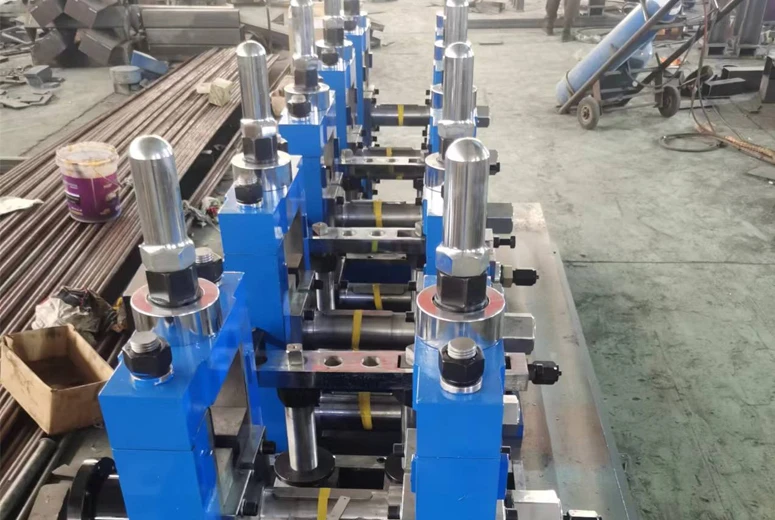light gauge steel roll forming machine
The Advantages and Applications of Light Gauge Steel Roll Forming Machines
Light gauge steel roll forming machines have emerged as essential tools in the modern construction and manufacturing industries. These machines are designed to create various lightweight steel sections that offer versatility, structural integrity, and aesthetic appeal. Understanding how these machines work, their advantages, and their applications can provide valuable insights into their growing importance in today's economy.
Understanding Light Gauge Steel Roll Forming
Roll forming is a continuous process in which metal sheets are fed through a series of rollers to produce specific shapes. Light gauge steel refers to steel sections that typically have a thickness of less than 3mm. These machines utilize high-precision technology to produce thin-walled sections that retain strength while minimizing weight. The production process generally involves the following steps
1. Material Feeding Raw steel coils are fed into the forming machine. 2. Forming As the material passes through multiple sets of rollers, it is progressively shaped into the desired profile. 3. Cutting Once the desired length is achieved, the formed steel is cut to size. 4. Finishing Finished products may undergo additional processes such as stamping or coating depending on their intended use.
This efficient process reduces material waste and production time, allowing manufacturers to meet high-demand scenarios promptly.
Key Advantages of Light Gauge Steel
1. Strength-to-Weight Ratio One of the most significant advantages of light gauge steel is its excellent strength-to-weight ratio. This characteristic allows for lighter construction materials without compromising structural integrity, making it ideal for various applications.
2. Cost-Effectiveness Light gauge steel roll forming machines can significantly reduce material costs. The efficiency of the roll-forming process minimizes waste, while the lightweight nature of the product can lead to lower transportation and handling costs.
3. Sustainability Steel is a recyclable material, making light gauge steel an environmentally friendly construction option. Many manufacturers increasingly focus on sustainable practices, and using recycled steel contributes to reducing the carbon footprint of construction projects.
4. Versatility The capability of light gauge steel roll forming machines to create various profiles means they can cater to diverse applications, ranging from residential construction to industrial buildings. They can produce sections used in walls, roofs, and floors, as well as framing and support structures.
light gauge steel roll forming machine

5. Design Flexibility Light gauge steel allows for intricate designs due to its ease of fabrication. Architects can design complex shapes and forms without worrying about the limitations of more traditional materials.
Applications in the Industry
Light gauge steel roll forming machines have found applications in several areas
1. Residential Construction The growing trend of modular homes and prefabricated buildings has increasingly relied on light gauge steel frame construction, yielding faster build times and reduced labor costs.
2. Commercial Buildings Light gauge steel is commonly used in commercial construction due to its durability and resistance to environmental factors. Designers utilize the material for everything from office buildings to retail spaces.
3. Industrial Uses Factories and warehouses benefit from light gauge steel's strength and adaptability. It’s used in the construction of large-span structures, which require reliable and cost-effective solutions.
4. Agricultural Structures Light gauge steel is often used for barns, greenhouses, and storage facilities, providing robust structures that withstand harsh outdoor conditions.
5. Infrastructure In modern infrastructure projects, such as bridges and roads, light gauge steel is essential for creating lightweight yet strong components, contributing to sustainability and efficiency.
Conclusion
Light gauge steel roll forming machines represent a pivotal advancement in the metal forming industry. Their ability to produce efficient, cost-effective, and sustainable steel solutions has made them indispensable in construction and manufacturing. As trends in architecture and building practices continue to evolve, the importance of light gauge steel will only grow, showcasing its role as a key player in future development. As we move toward a more sustainable and efficient construction industry, light gauge steel will undoubtedly be at the forefront of this transition.
-
High Frequency Straight Seam Welded Pipe Production Line-BzZhou Xinghua Machinery Equipment Manufacturing Co., LTD.|line pipe steel&welded gas pipeNewsJul.30,2025
-
High Frequency Straight Seam Welded Pipe Production Line-BzZhou Xinghua Machinery Equipment Manufacturing Co., LTD.|High Precision&Automated SolutionsNewsJul.30,2025
-
High Frequency Straight Seam Welded Pipe Production Line - BzZhou Xinghua Machinery Equipment Manufacturing Co., Ltd.NewsJul.30,2025
-
High Frequency Straight Seam Welded Pipe Production Line-BzZhou Xinghua Machinery Equipment Manufacturing Co., LTD.|Precision Welding, High EfficiencyNewsJul.30,2025
-
High Frequency Straight Seam Welded Pipe Production Line|BzZhou Xinghua|Precision Welding&EfficiencyNewsJul.30,2025
-
High Frequency Straight Seam Welded Pipe Production Line - BzZhou Xinghua|Precision Engineering&EfficiencyNewsJul.30,2025


